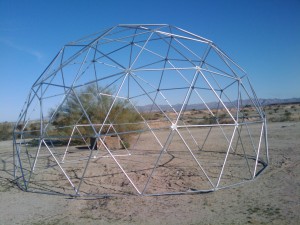dome, finished
- March 16th, 2010
- Posted in East Jeus . images
- Write comment
The dome crew were unable to complete the bottom-up assembly of the dome due to its high apex and our collective lack of tall enough ladders. It was also ascertained that one of the vertices was the wrong length. For these reasons, and because I had trouble sleeping at night with an unfinished dome in the yard, I performed an experiment to see if one Charlie, solo, could dis- and re-assemble the whole thing from the top down without the use of ladders or scaffolding.
Dis-assembly was relatively easy. The errant vertex was found to be an A strut cut two inches too long, so correcting this was no problem: re-cut, pound flat, bend, drill. Re-assembly was possible and not terribly difficult, even upon the soft, uneven ground at this location. Using only a Hi-Lift farm jack, a 4′ length of 4×4, a small hammer, c-clamp, vise grips, open-end wrench and ratchet, I nailed this puppy together in about a day. A 3V dome is easy to understand in terms of vertex mapping – the A struts are always and only the radials of pentagons; the C struts are likewise the radials of (regular) hexagons, and the B struts “frame” both. Simply arranging the A, B and C vertices into (very carefully) sorted piles is enough; no need for color coding or banding for identification. I did, however, double-check the length of each piece before using.
Next: a 4V half-dome with a radius of perhaps 8′ for a sweat lodge. Back to the nifty calculator at desertdomes.com…

How about covering one of the domes with clear plastic and creating a tropical greenhouse? It would be a nice contrast to the desert. Cheers
A greenhouse would be great, if’n I had a well already Actually, the Imperial Valley has three growing seasons and greenhouses aren’t really necessary for most crops. And greenhouses typically can be much lower to the ground, ergo *cheaper* than this dome, which was about $550 outright for materials, as is (uncovered.) A greenhouse needn’t be tall nor round.
Actually, the Imperial Valley has three growing seasons and greenhouses aren’t really necessary for most crops. And greenhouses typically can be much lower to the ground, ergo *cheaper* than this dome, which was about $550 outright for materials, as is (uncovered.) A greenhouse needn’t be tall nor round.
This dome was initially conceived as a simple skeleton, as pictured, for its own sake. Upon completion, though, I began thinking about planting grapes and morning glories to eventually enclose the entirety in green, living shade, probably with an internal misting system to keep occupants and said green friends happy… I don’t know of anyone else who’s tried that, so I might as well be the space monkey…